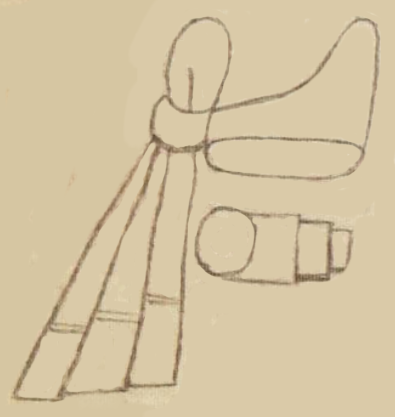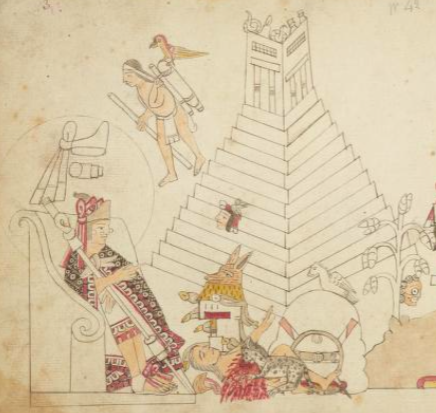Motecuhzoma Xocoyotzin (Azca28)
This black-line drawing of the compound glyph for the personal name Motecuhzoma (in this case, the younger, Xocoyotzin) is unglossed. The key elements are the diadem (xiuhhuitzolli) that came to serve as the symbol for lord (tecuhtli), supplying the middle part to this name (-tecuh-) and a lip or other facial-type of ornament, which has an association with this ruler. The reflexive Mo- and the final part to the name, -zoma (to frown in anger) are not shown visually.
Stephanie Wood
This glyph is not glossed, and so we would normally classify this as an example of iconography. We are presuming to identify the glyph based on the order of succession of the rulers in the manuscript and the similarity of this glyph to others for the same person. A bas relief stone carving on the underside of the lid of the so-called "Caja de Moctezuma Xocoyotzin," Museo Nacional de Antropología e Historia, Salón Mexica, shows a similar xiuhhuitzolli, which the museum signage refers to as the "imperial headdress." The compound glyph on the stone also has some face ornamentation and a speech scroll (tlatoa, to speak), indicating that this man had the power to speak, being a tlatoani. The glyph here from the Codex Azcatitlan has fewer added elements, and it lacks the hair (tzontli), which can serve as a phonetic complement to -zoma. See our record for Motecuhzoma (Mdz15v), which includes a photo of the bas relief carving. Also, the examples below show that the diadem alone can serve as a glyph for Motecuhzoma, perhaps both the elder and the younger.
Stephanie Wood
post-1550, possibly from the early seventeenth century.
Jeff Haskett-Wood
emperors, empires, rulers, gobernantes, emperadores, imperios, diademas, Montezuma, Moteuczoma, labrets, enchufes, tapones, labios, bezotes, adornos labiales, jewelry, jollas, lip plugs, lip-plugs, teuctli, nombres de hombres, personas famosas

Motecuhzoma, the name of two rulers of the empire, the first was Ilhuicamina, who came to power in the mid-fifteenth century, and the second was Xocoyotzin, who was ruling at the time of the Spanish invasion, https://nahuatl.wired-humanities.org/content/motecuhzoma
tecuh(tli), lord, https://nahuatl.wired-humanities.org/content/tecuhtli
zoma, to frown in anger, https://nahuatl.wired-humanities.org/content/zoma
posiblemente, El Que Se Muestra Enojado, pero es el nombre del famoso emperador que gobernaba cuando los españoles invadieron
Stephanie Wood
The Codex Azcatitlan is also known as the Histoire mexicaine, [Manuscrit] Mexicain 59–64. It is housed in the Bibliothèque Nationale de France, and hosted on line by the World Digital Library and the Library of Congress, which is “unaware of any copyright or other restrictions in the World Digital Library Collection.”
https://www.loc.gov/resource/gdcwdl.wdl_15280/?sp=28&st=image
The Library of Congress is “unaware of any copyright or other restrictions in the World Digital Library Collection.” But please cite Bibliothèque Nationale de France and this Visual Lexicon of Aztec Hieroglyphs.







